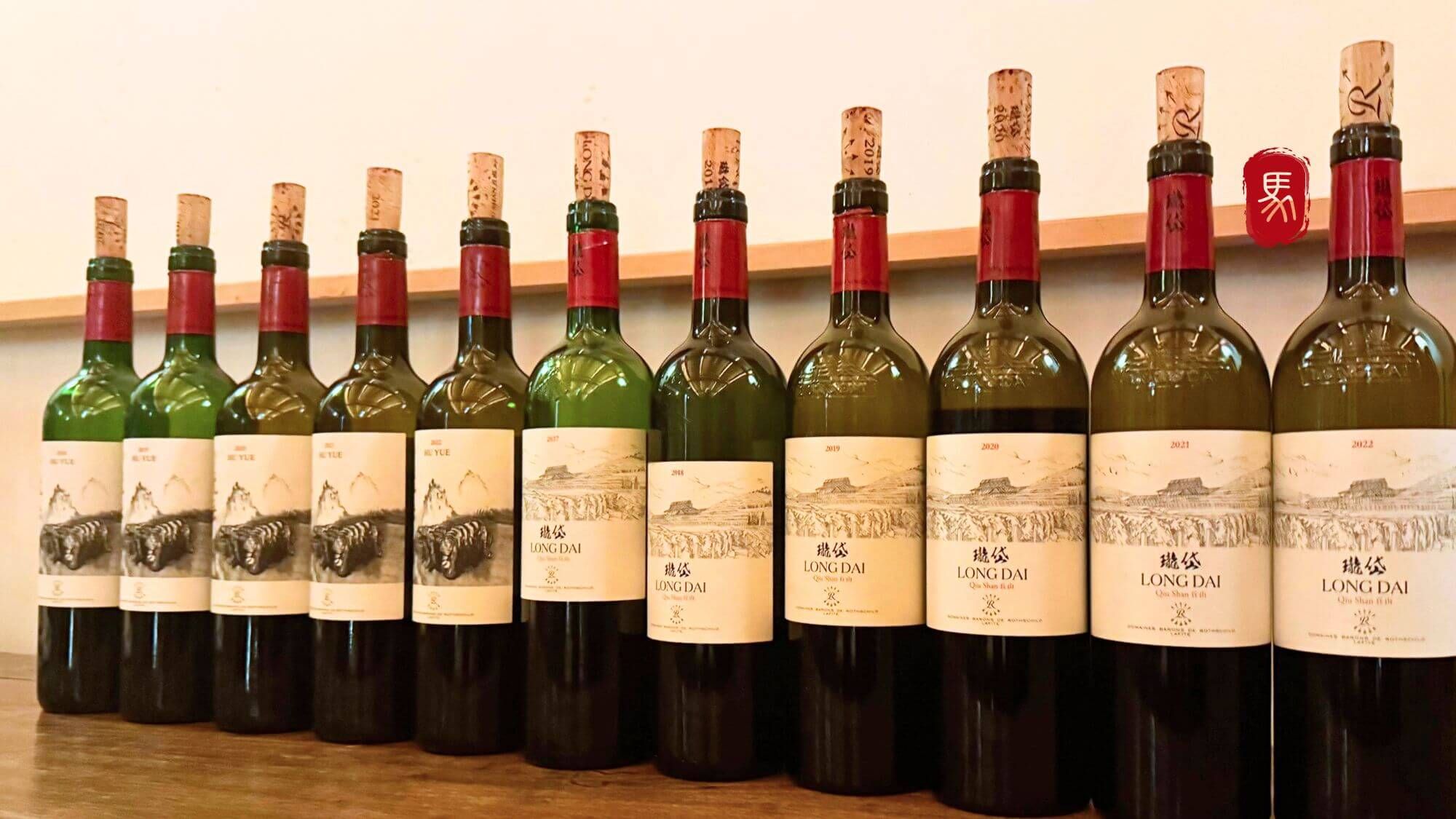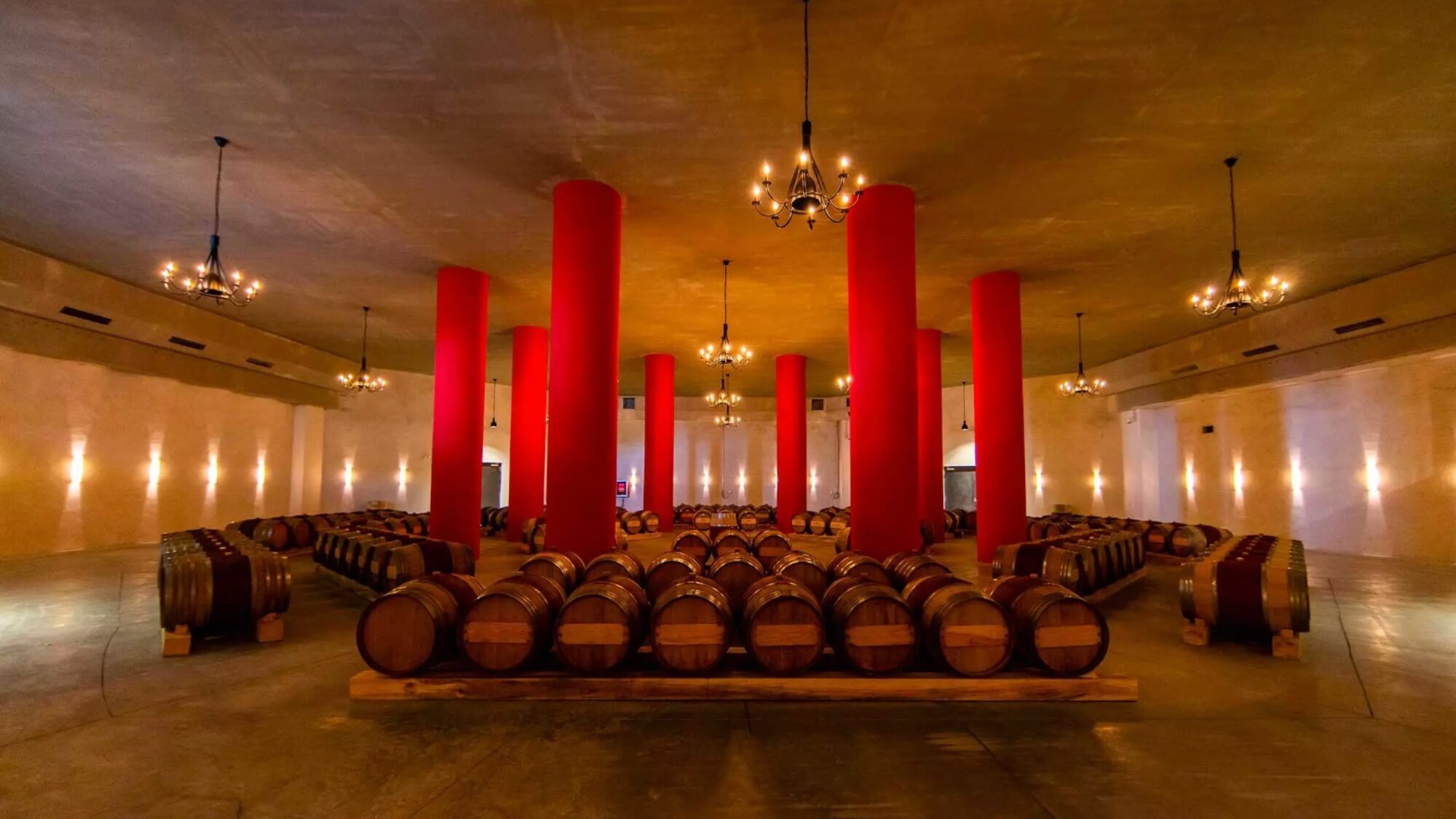AMA Vertical Tasting
Domaine de Long Dai
(2017-2022)

Anyone familiar with the climate of Yantai and Penglai knows that crafting top-tier wines in a region where rainfall comes and goes as it pleases is far from easy.
This inevitably raises a question: as a winery founded by DBR Lafite in China, can Long Dai truly produce wines that astonish the world? And could it one day become the label that international wine lovers instinctively associate with Chinese premium wine?
With these questions in mind – and with a promise I made to myself a year ago – I set off for Long Dai this October.
By the time I finished the estate tour, it was already close to five in the afternoon. I assumed the tasting would start the next day, but the moment I stepped into the tasting room, I was greeted by an entire line-up of Long Dai and Hu Yue, all opened and breathing, waiting for me. The team was remarkably generous: every released vintage laid out in one go. I’ve seen this kind of set-up in Bordeaux, but in China, it was my very first time.
Well then – no need for further hesitation. Time to dive right in.

01|AMA Snapshot of Long Dai
Let me start with my overall impressions from this vertical tasting. In short, I have six main points to share:
First, the differences between vintages are enormous.
Influenced heavily by shifts in rainfall and temperature, Long Dai shows even greater year-to-year variability than Bordeaux. Each vintage carries its own personality—some more expressive, some more restrained. For this reason, I strongly suggest identifying the style you prefer before buying Long Dai or Hu Yue; otherwise, a single vintage may give you an incomplete picture of the estate. I’ve recorded the detailed characteristics of each vintage in the tasting notes on my website, and I recommend taking a close look.
Second, the “fundamental tone” of Long Dai.
Despite the wide variation across vintages, they all share a few core traits: a lively, juicy palate, a savory and tightened finish, and aromas that are restrained yet precise. These recurring features form the inherent signature of Long Dai.
Third, harmony is shaping up to be Long Dai’s defining strength.
Before the 2021 vintage, the transitions between the elements of the wine were still a bit tentative. But by 2022, the overall rhythm had become notably more aligned and seamless. I could even sense, through the glass, a new level of confidence from the winemaking team – something not often felt in earlier vintages.
Fourth, dry and warm vintages tend to bring out the best.
Take 2019, for instance—a vintage on which my thoughts differ slightly from the estate’s. While the team believes that such a warm, dry vintage does not fully reflect Long Dai’s gentle character, I see it differently. In a region where vintage variation runs so wide, dry and warm years can actually bring better concentration and energy, unveiling a rare touch of masculinity in this terroir. Of course, such vintages also mean significantly heavier irrigation work for the vineyard team.
Fifth, the unexpected charm of Marselan.
In vintages with a higher proportion of Marselan, Long Dai often shows a distinct “sweetness”, and the overall texture becomes smoother and more cohesive. This was especially evident in 2021 (31% Marselan) and 2022 (34%). It delivered a striking improvement in what I often describe as the “gentle wrap around the core of the wine.”

02|What Does “Grand Vin” Mean in the Eyes of DBR Lafite?
Long Dai is the first estate in Lafite’s history to be built entirely from scratch by the family themselves. Baron Eric de Rothschild once said with a smile that making great wine takes time and patience; perhaps he would never see Long Dai in its most perfect form within his lifetime, but his descendants certainly would.
And so, on a piece of land with no historical record, they spent a full decade pursuing the answer to a single question: What should a Lafite-style Grand Vin look like in China?
Ten years of trial and exploration – marked by successes as well as setbacks – slowly brought them closer to that ideal.
From what I know about the French and about Bordeaux estates, their ambition goes far beyond producing a “good wine.” What they truly aim to create is a Grand Vin that belongs to China, a wine capable of carrying the voice of Qiushan (丘山) to the world.

03|Why Choose Qiushan (丘山)?
During my visit, I couldn’t resist asking the team a slightly tricky question: “Since Yantai is coastal and most of its rainfall hits during the growing season, why did you choose Qiushan instead of another region?”
Their answer was, in true “Shandong style”, straightforward and sincere. As I learned, the Rothschild family had originally surveyed all of China’s major wine regions. Because of the challenge posed by burying vines in winter, they quickly ruled out most of them. In the end, only two remained: Yunnan and Shandong.
Yunnan doesn’t require winter burial, but the UV intensity in Shangri-La is extremely high, making canopy management completely different from Bordeaux. Combined with the region’s complex terrain and limited accessibility, Yunnan eventually fell out of consideration. Their attention then turned to Penglai in Shandong.
After several field studies, they discovered a place called “Qiushan.” Its microclimate is notably warmer, with over 2,000 accumulated sunshine hours each year. The old terraced fields offered excellent drainage, and the nearby Mulan Gou village (木兰沟) had many experienced farmers. With all these factors combined, the choice suddenly became obvious.
If you ask me what Qiushan’s climate is like, I’d borrow Mr. Shao’s wonderfully concise description from that day:
“Dry and windy in spring, hot and rainy in summer, dry and cool in autumn, mild and snowy in winter.”
At first glance, it doesn’t sound too bad – but for winemakers, rainfall is a formidable challenge.
The area receives about 600 to 800 millimeters of rain annually – not an excessive amount, but most of it falls squarely during the growing season, often in the form of short, intense storms. This makes the impact of rainfall impossible to predict each year, and it remains the greatest uncertainty in Long Dai’s wine quality.
Fortunately, in recent years, Qiushan’s sunshine hours have increased from around 2,000 to 2,200. As long as rainfall during the growing season doesn’t become overly concentrated, ripeness can still be achieved.

04|The Story of Granite and Colored Flags
The soils of Qiushan’s vineyards are generally shallow, formed from the weathering of granite and mixed with stones, clay, and sand. This terrain varies significantly in drainage, nutrient content, and even soil depth, creating an extremely complex growing environment. Combined with the natural elevation changes of the terraced slopes, grapes within the same vineyard often reach maturity at completely different times – which adds considerable difficulty to vineyard management.
To navigate this complexity, the Long Dai team adopted an impressively creative approach: they first used satellite remote sensing to monitor ripeness levels across the plots, then paired the data with on-site observations and marked each stage of ripeness with different colored flags. Once harvest season arrived, workers simply followed the colors to pick every parcel at its optimal moment.
Imagine the scene – colored flags fluttering in the wind, the calm sea stretching out beyond, and a vineyard where technology and craftsmanship work hand in hand. Perhaps this is the very image of the Chinese wine spirit Long Dai has been searching for.

05|Long Dai’s Winemaking Philosophy
Stepping into Long Dai’s winery, you won’t find the “old-money aesthetic” one might imagine. Instead, what strikes you is a calm sense of order. The fermentation tanks are arranged across two levels: the upper level for alcoholic fermentation, and the lower level for processes related to maceration. After harvest, the grapes rest overnight in a cold room before being destemmed and transferred into tanks the next morning, with fermentation temperatures strictly controlled between 24 and 28°C.
In speaking with the winemaking team, I learned an interesting detail worth sharing. They choose to inoculate lactic acid bacteria during the mid-to-late stages of fermentation, allowing alcoholic fermentation and malolactic fermentation to run simultaneously. In Bordeaux, this approach is considered somewhat “risky,” as it may prevent certain aromatic compounds from fully developing. But Long Dai believes that stabilizing the wine before barreling not only saves time, but also reduces uncertainties during aging—a choice that reflects both their confidence and their pragmatic approach to winemaking.
Long Dai is equally cautious when it comes to oak. Depending on the vintage, about 60% of the wine is aged in their “Bagua” cellar, with new oak kept between 20% and 25%. In 2017, their first vintage, they experimented with 50% new barrels, but later realized that the oak overwhelmed the fruit and terroir expression, prompting a significant adjustment.
As for Hu Yue, the estate follows a lighter touch in its élevage: the wine ages for 12 months, with oak kept below 40%, of which only 15% is new.
To me, it represents a more direct and approachable expression of Long Dai – one that deserves just as much attention.

06|The Close Bond Between Long Dai and Mulan Gou Village (木兰沟)
The day I left the estate happened to coincide with the wedding of a Long Dai employee. The celebration was held right at the entrance of the village, bustling with people, and several shuttle buses came and went just to bring guests in.
Since Long Dai settled here, Mulan Gou – once considered a “poor village” – has become the most sought-after place in the area.
While chatting with one of the villagers, I could sense his genuine sense of contentment. With a smile, he said, “I rent my land to the estate and receive rent. I also work at the winery, so that’s another income. And my family still keeps our apple orchard – that’s a third. Put all three together, and it’s truly a decent living.”
He paused for a moment, then added, “Twenty years ago, Mulan Gou was so poor that no one wanted to marry their daughter here. But now? Having a son-in-law from Mulan Gou is something families are genuinely happy about.”
As he finished, his eyes crinkled into a web of lines, his entire face brightening with joy.
In that moment, I realized that Long Dai had brought more than steady income to Mulan Gou. It had given the village a renewed sense of identity, a dignity rooted in their land, and a warmth and confidence that naturally emerge when life begins to treat you more gently.

07|Closing Thoughts: I’ve Found My Own Answer
After a full day of exploration at the estate, I saw the immense potential of Penglai, and I also saw the Long Dai team’s almost obsessive level of focus.
They refine every detail, polishing their craft year after year, using a touch of French elegance to interpret Chinese terroir.
Can Long Dai become the benchmark that represents Chinese wine?
I’ve come to feel that the question itself no longer matters.
Because the true meaning of Long Dai lies beyond producing a single Grand Vin.
It lies in opening the world’s eyes to what Chinese wine can be.
Its moment of success may not be today – but one day in the future, it will arrive quietly…
